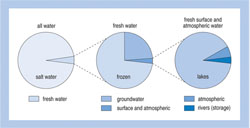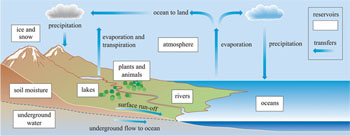13.3 The hydrological cycle
Water is in plentiful supply on our planet but most of it is not available for human use. Over 97% of the world’s water is in the oceans and is salty. Fresh water, found in rivers, lakes and within the ground, accounts for less than 1% of the total (Figure 13.2). It is not distributed evenly around the world. There is a surplus in some places and scarcity in others.

Water is in continuous motion in a series of processes called the hydrological cycle or water cycle that governs the health of the planet. (Hydrology is the study of water, hence the alternative name for the water cycle.) Figure 13.3 shows a diagram of the water cycle. Without continuous evaporation from the oceans, precipitation on land and runoff back to the oceans, there would be no recharge (replacement) of surface and groundwater.
There are several important terms here that need explanation. Evaporation is the change from a liquid to a gas. When the sun shines on the surface of water, water molecules evaporate from the water body into the atmosphere above. Precipitation simply means water falling from the atmosphere to the Earth’s surface; mostly this means rain, although it also includes snow. Runoff includes all water that flows, under the force of gravity, across land in streams and rivers and across the surface, for example, of a field. Groundwater includes all water that is found underground within the rocks; some groundwater may be near the surface and some may be deep underground.
In Figure 13.3, the transfers (the movements or flows) of water are shown as arrows and the reservoirs (stores) as boxes. Note that the word ‘reservoirs’, in general speech, refers to artificial lakes that have been constructed to store water at the surface. In the context of the water cycle and hydrology, reservoir means all stores of water. Another term included in Figure 13.3 is transpiration, which is the release of water vapour (water as a gas) from plants and soils into the atmosphere. Evaporation and transpiration are sometimes referred to together as evapotranspiration.
13.2.3 For hygiene

